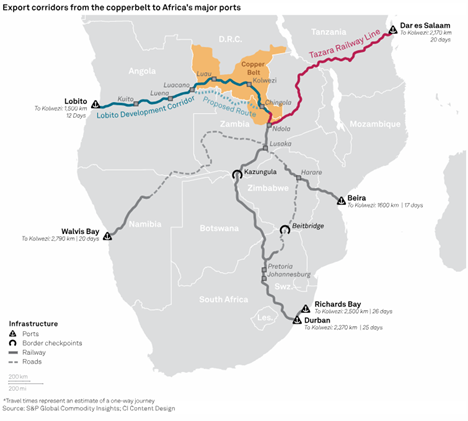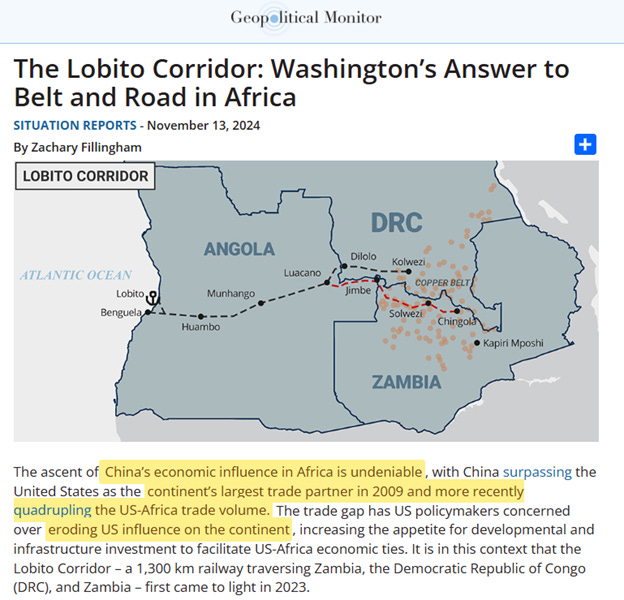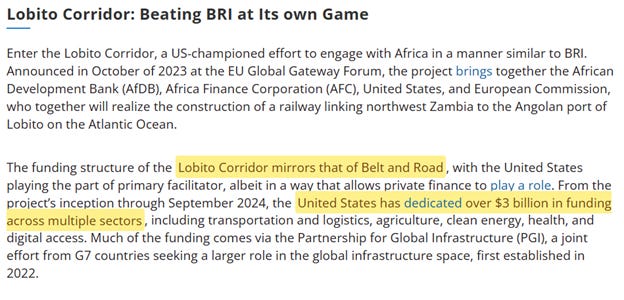Bullets:
Zambia sits upon some of the world’s richest copper ores which are highly prized by China’s factory sector and by Western companies.
Inside China / Business is a reader-supported publication. To receive new posts and support my work, consider becoming a free or paid subscriber.
The race is on to build a railroad to Zambia. The US and EU hoped to lay track through the DRC, which would connect Zambia to Lobito, a port on the Atlantic Ocean.
Chinese companies decided on multibillion-dollar upgrade to an existing railway from Tanzania, called the Tazara Line.
The Lobito Plan was doomed from the start. Financing for the project fell apart as the Trump Administration froze funds, and the war in Ukraine bled dry the EU’s budgets.
The Tazara Line, meanwhile, is already laying new track, and Chinese mining companies are signing deals across Zambia to bring new copper and cobalt production online.
This is a transcript, for the YouTube video found here:
Report:
Good morning.
China’s Belt and Road Initiative has completely transformed the economies and supply chains for the world, and Western governments are pretending to want to do something about that. And recent developments in Africa serve as a great case study as to why the BRI is successful, and why our own attempts to slow it down aren’t working.
The shaded area at the middle of that map, which is of Southern Africa by the way, is the Copper Belt. It’s the world’s primary source of copper ores, and is concentrated in the DRC—the Democratic Republic of the Congo—and in Zambia. Note too that Zambia is landlocked, and so is dependent on overland transportation to export anything to global markets. And it follows from there that Zambia needs strong diplomatic ties with any of their neighbors they hope to export through.
The Lobito Development Corridor is the Westbound train, from copper mines in the DRC to Lobito, a port on the Atlantic Ocean. There is a recent proposal to add another route which will benefit miners in Zambia. Going the other way is a railway line that already runs from Zambia, Eastbound, to Dar es Salaam. The Tazara Railway Line was built decades ago, and urgently needs to be upgraded if it’s to carry heavy cargoes like copper ores.
So that’s a summary of where things stood, and we have two pieces from 2024 which explain plans for that railway expansion into Zambia, for access to Western markets. The entire motivation is to counter China, which has enormous economic influence in Africa. In 2009 China became Africa’s biggest trade partner. Now the US is playing catch-up against China’s BRI, a “colossal infrastructure and economic development project spanning” three continents. In 2023 alone, China put over $21 billion into Africa. The idea is that the Lobito Corridor will “mirror” the Belt and Road.
But that isn’t true, and this helps us see the problem more clearly. This comes from the Lobito Corridor Investment Promotion Authority, which is just what it sounds like. It’s an agency seeking private investments for the project. It is a US and EU project, and a partnership with three countries: Angola, the DRC, and Zambia. Then comes the African Finance Corporation and the African Development Bank, and then some more from the PGII which collects and manages the money, almost $1 billion so far. From the US, the Development Finance Corporation is doing due diligence for $250 million, and the EU has pledged a billion to African infrastructure, which includes this project but doesn’t say how much.
This structure is already unwieldy and wobbly, then, and subject to whatever political winds are blowing in those three African countries, and also in the European Union, and in the United States who is now under new management with the Trump Administration.
It gets even more complicated, as the entire financing of the project from the operations side is based on high freight volumes from companies with proportional ownership, and then again through their subsidiaries. Mining companies in Africa are already frustrated with transportation out of the DRC because of truck driver strikes and illegal road tolls, and so they love the idea of a railroad that might avoid those things. The bad news there, of course, is that railroad strikes also happen all the time, and any train passing through any jurisdiction can also be stopped and the traffic disrupted, and we should suppose the people most motivated to do that would be those truck drivers who are now out of jobs.
Here is the biggest irony of all, though. Even if this US-EU railroad gets built, it’s more likely to be Chinese companies that use it. China is the biggest consumer of copper; this is where the industries are that need it. Chinese companies already control many of the mines in the region, and sell to customers here in China, and this railroad may simply make their lives easier. “Western governments must ask themselves exactly what they’re trying to achieve.” It won’t change the big picture at all.
So to nobody’s surprise it didn’t take long for the wheels to come off. This piece is from November 2024, “Beating BRI at its own game”, with $3 billion invested in a group of projects.
Three months later the US froze the funding that goes to the Lobito expansion. The money budgeted for feasibility and engineering studies was blocked. The EU says they’re still in, but the new administration is unpredictable, and nobody can say for sure what the policy is on critical minerals. China already enjoys “unmatched leverage across the Global South”; the Biden Administration approved the project, but the new Administration is going a different way, but nobody really knows what that is. For now, though, the US is out, and that leaves the EU with a problem.
The European Union also had hoped to secure supply chains from central Africa with the railroad, but now they’ll need to pay more to make it go through if the US pulls out. And the EU’s problem is that they’re out of money anyway. The war in Ukraine is bleeding them dry, and several governments have already quietly said they can’t follow through with the plans for Zambia. This analyst concludes that the EU can show themselves to be good partners by withdrawing slowly, instead of all at once, so the Africans can have some time to find new sources of capital. The end result is the same, though—the US is out, and the EU is probably also out.
That’s from February. In April, a US diplomat said that the project is still on, despite Trump’s aggressive cuts. The first phase is reportedly still a go, refurbishing the line through Angola to the DRC. But right there is Zambia’s problem: they won’t get a railroad until later, anyway. That’s phase two of the project.
By June, African governments were demanding answers on the railroad, the new high tariffs on Africa, and increased restrictions on visas for Africans.
Now it’s October, and the entire US government is shut down. The first day of that, the Trump Administration froze billions of dollars that were going to upgrade New York City’s subway system. Everyone already knows that the California high speed rail project is dead, at least from the point of view of the administration. To Zambia, all that adds up to the realization that a Westbound railroad isn’t going to happen.
Going East is the only way. Zambia “can be key in securing China’s access to copper”, and by doing so, “Zambia’s economic future is assured.” Chinese mining companies are already very active in country—they just need a better railroad.
Mr. Chabala was chairman of Zambia Railways, and he knows what’s coming next: China will build the railroad, get a concession to run it, and the West won’t be getting any copper from Zambia. Doesn’t matter if the Lobito Corridor happens or not—it’s already too late, China has already integrated mining and logistics in Africa.
All Zambia needs is a better railroad, and so China will build it, a $1.4 billion upgrade to the Tazara line, which again runs from Tanzania to Zambia. Besides the miners, the project will mean more export markets for farmers and merchants.
This one goes deeper. It’s important for China as well, and for this one company, the Civil Engineering Construction Corp. This by the way is a feature we hear often, that China is a one-stop shop for infrastructure. Negotiations take awhile, but it’s the financing, the engineering, the management expertise, the raw materials—all of it.
The Chinese firm gets a 30-year concession under this business model, which this analyst called “refurbish-operate-transfer”. There are no loans involved—the company builds the rail line and operates it until it gets its investment back, then turns it over to local authorities.
Copper is a critical mineral, and the investment is a no-brainer, according to him. Chinese firms get control over a key transport route for copper and cobalt. Since a Chinese company is managing the railroad, it is assured markets and revenues.
Lobito, if and when it ever gets finished, is like a single thread in the carpet. But China is knitting the whole carpet. And since Tazara now looks like a done deal, the economics of Lobito make no sense for anybody.
Resources and links:
US$1.4 billion Tazara rail deal puts China on fast track to Africa’s Copperbelt
US envoy plays down Africa tariff, visa concerns, reaffirms Lobito rail commitment
Zambia Banks on China-Backed Rail Upgrade to Boost Mining Exports
Reuters, US committed to funding Angola’s Lobito rail corridor despite spending cuts, diplomat says
Reuters, China signs deal with Zambia, Tanzania for $1.4 billion railway upgrade
Debating Trump 2.0 and Implications for Africa - Reality Check for Zambia: Resilience in the Face of US Aid Cuts?
Lobito corridor railway project Faces Uncertainty Amid US Aid Freeze
https://www.railway.supply/lobito-corridor-railway-project-faces-uncertainty-amid-us-aid-freeze/
The Lobito Corridor: Washington’s Answer to Belt and Road in Africa
China Pledges $1.4B to Upgrade Zambia-Tanzania Rail Amid Global Minerals Race
China, Tanzania and Zambia seal deal to revitalize TAZARA railway
https://global.chinadaily.com.cn/a/202510/01/WS68dcfb50a310f735438b348b.html
New York Times, Trump to Withhold $18 Billion for New York-Area Transit Projects
https://www.nytimes.com/2025/10/01/nyregion/trump-nyc-subway-gateway-infrastructure-funding.html
Duelling Rail Projects Hint at Intensifying Contest for Africa’s Critical Minerals
US Department of Transportation, Trump’s Transportation Secretary Sean P. Duffy Pulls the Plug on $4B for California High Speed Rail’s Train to Nowhere
Inside China / Business is a reader-supported publication. To receive new posts and support my work, consider becoming a free or paid subscriber.
From Inside China / Business via this RSS feed






